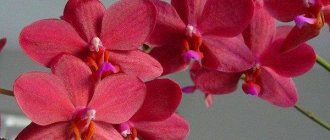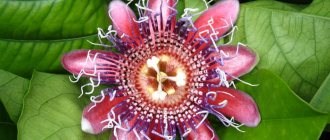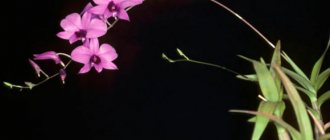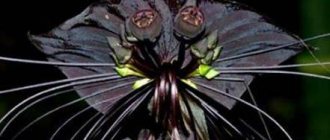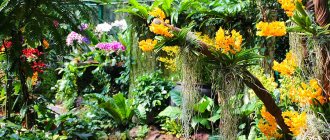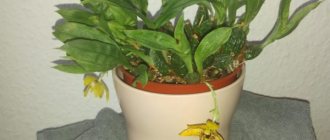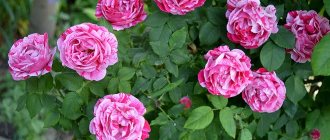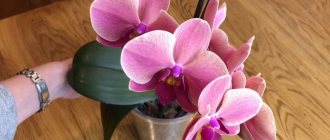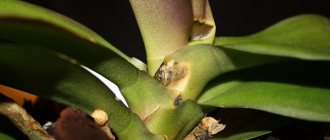Plants » Flowers
0
1586
Article rating
Kira Stoletova
Orchid is an exotic ornamental flower, the largest family of monocots. There are many different types of this plant, which mainly differ in the color and shape of the flowers, one of them is the burgundy orchid.
Characteristics of burgundy orchid
Landing rules
Priming
In nature, the flower grows on trees, attached to the bark.
The substrate for a home beauty should be similar to natural conditions. The mixture includes: pieces of bark, coarse sand, humus, lowland peat, perlite, charcoal, drainage made of expanded clay or pebbles at the bottom (up to a third of the height of the container). Sphagnum moss is laid on the surface.
Optimal capacity
Clay pots work well for the development of red orchids. Transparent containers allow you to better control the condition of the plant.
Deadlines
The need to move a flower to new soil occurs no more than once every two years. The roots sticking out of the pot signal that it has become cramped. The correct time for this procedure is after flowering has ended.
Orchids are replanted every two years.
Features of care
In order for your burgundy Phalaenopsis to live happily ever after, you must adhere to a huge number of rules and listen to many advice from experienced botanists.
Firstly, know that you won’t be able to place a flower where you want without risking the health of the plant. Direct exposure to sunlight will certainly have a bad effect on the general condition of the flower, and may even ruin it.
Secondly, it is necessary to maintain the air temperature familiar to the orchid. If it exceeds the set norm or drops to a critical level, Phalaenopsis will die. It is worth taking into account that this is a tropical plant and does not tolerate cold well.
Thirdly, the air around the orchid must be humidified. In nature, the flower grows in very rainy places and loves water very much.
Fourthly, of course, the orchid has a love for water, but there is no need to overwater it, otherwise you will seriously damage the roots. Rotten water will form at the bottom of the pot and cause the roots to rot. Under natural conditions this does not happen, because there the moisture goes further into the ground.
Also stock up on fertilizers, since in ordinary soil where you plant the orchid, there will not be enough vitamins and minerals for the flower to grow fully.
Lighting
Now let’s take a closer look at all the requirements for proper flower care. Let's start with the simplest thing - the correct reception of light rays for normal plant photosynthesis. The burgundy orchid is characterized by bright places, warm, heated air, so it is best to place it in the western or eastern part of the house, on a window.
Why is the south side not suitable? There the sun may not be merciful, capable of burning the orchid leaves. In winter, the sun's rays will be critically lacking, so use additional lamps. Acceptable daylight hours for a plant are up to 12 hours.
Watering
Burgundy orchids should also eat in moderation. For them there is, so to speak, their own special diet. Thus, in the summer, 1 dose of water per week is enough for the flower; this regime must also be observed in the case when Phalaenopsis does not feel very well. In winter, look at how dry the soil will be. The condition of the water is also important. Before watering, it must be left to stand; melted or rain moisture will also do.
Note that the flower must be watered and washed so that dust does not cover the leaves of the orchid in a thick layer, otherwise it will affect its condition, the plant may get sick and wither.
Air temperature and humidity
Due to the fact that in nature the orchid grows in the tropics, it is not surprising that the plant loves high humidity and heat, and does not easily tolerate cold winter waters.
Burgundy Phalaenopsis can withstand air temperatures up to 30 degrees Celsius, and can die when it drops to 15 degrees. Sudden changes of 10 degrees cause the plant to hurt, so you should try to avoid this in indoor conditions.
As for humidity, the air should be kept no less dry than 50% and no more humid than 70%. These conditions are the most favorable for the orchid.
Soil and pot
Please note that soil from the garden may not be suitable for a burgundy orchid, since it will not contain all the substances and microelements it needs. Therefore, know that when choosing land you need to ensure that it is loose and light, containing drainage from expanded clay and pebbles, as well as pine tree bark, coal and sphagnum moss.
Buy a transparent flowerpot, made of good plastic, with holes on the sides and bottom for fertilizer. It is best if the height and length of the pot are equal. All these requirements will help the roots of the burgundy orchid feel free in the flowerpot.
Fertilizer
Do you want your burgundy orchid to grow quickly and well? Then buy fertilizer. It must be purchased strictly in specialized stores. Before you buy fertilizer, read what is written on the package, and pay special attention to whether the fertilizer can be used for orchids.
After purchase, fertilizers must be applied simultaneously with watering. This will not be difficult, because both should be done once a week. When the baby orchid begins to grow, it is necessary to pay special attention to fertilizers. Use magnesium sulfate, nitrogen and calcium nitrate in a 1:3:1 ratio.
Transfer rules
Let's pay a little attention to replanting the Phalaenopsis orchid. Botanists recommend using the transshipment method. It consists of the following steps: the substrate needs to be soaked and placed in an epin solution for 30 minutes, then, carefully freeing the roots of the plant from the old substrate and washing them, get rid of the damaged, rotten ones.
We recommend treating the cut areas with cinnamon and then drying them. After all these machinations, you can finally transplant the flower into a new disinfected substrate and, after 10 minutes, water the orchid.
Varieties names of phalaenopsis orchids:
Phalaenopsis Blue
Phalaenopsis with blue flowers look very exotic; it is this color that gives the trunk additional unusualness. But not everyone knows that orchids with this color of flowers do not exist in nature; their DNA does not have a gene that gives this color to the petals.
Phalaenopsis with blue flowers.
Blue Phalaenopsis are obtained using staining, which is carried out using a special technology:
- watering dyeing;
- staining with the introduction of blue pigment.
The first method is more gentle on the plant, but less effective. In addition, subsequently not only the petals, but also the stem will be colored, and the duration of the color change will be short-lived. As soon as you stop watering with the blue substance, the colored flower will quickly return to its original state. The second type of dyeing is very dangerous, but if you decide to go with it, try to choose the most gentle method of introducing the dye. The paint is introduced by injection into the peduncle, into the stem or into the root.
In most large flower shops, information that painted Phalaenopsis is hung near the shelf with flowers. Some sellers, on the contrary, try to present the painted trunk as something supernatural and sell the plant at a very inflated price. At the same time, the quality of the coloring itself leaves much to be desired.
It all started in 2011 at a tropical plant exhibition in Florida. It was there that the phalaenopsis orchid with blue flowers was put on public display for the first time. Manufacturers did not hide the fact that their standard was painted. They patented the process technology and still keep it a closely guarded secret. Three months later, a tropical beauty with a similar color was presented in Europe. It was shown by Dutch breeders; the fruit of their development is also a colored standard.
However, as a result of crossing, it was possible to obtain varieties with blue shades of petals (see above, blue hybrids).
The world's first blue phalaenopsis, Aphrodite blue, obtained through genetic engineering.
The only type of blue orchid that can be called natural is Phalaenopsis Aphrodite, bred in Japan. This species is the fruit of many years of experiments by a group of genetic engineers and breeders at Chiba University.
The plant with white flowers was given the “blue” gene from the flower of Commelina (or blue-eye), which is native to Asia. The blue orchid Phalaenopsis Aphrodite is very prolific - it can produce up to thirty small flowers with a diameter of five cm in one flowering. But, unfortunately, at the moment Phalaenopsis Aphrodite is not available to ordinary plant growers.
How to choose an orchid
You can find an orchid in flower shops at any time of the year. However, experienced gardeners warn that you should not buy a heat-loving plant if the outside temperature does not exceed 0°C. During transportation, the tropical plant may freeze and die. In addition, it is not recommended to purchase a flowering plant: it spends a large amount of energy on flowering, and is greatly depleted. It is possible that a blooming red orchid that has stood for a long time in a store window will die after moving.
When purchasing, it is important to pay attention to the condition of the plant’s root system. The first thing to do is check how tightly the plant “sits” in the pot. To do this, you need to carefully grasp the base of the orchid stem and move it slightly
If the flower is unstable, it can be assumed that it was recently replanted. You should not purchase such a plant - it has not yet taken root. The roots of the orchid should be dense and elastic. The fact that the plant is healthy is indicated by the light green tint of the roots. Brown or dark gray roots indicate fungal diseases, excessive moisture, and mechanical damage to the root system
To do this, you need to carefully grasp the base of the orchid stem and move it slightly. If the flower is unstable, it can be assumed that it was recently replanted. You should not purchase such a plant - it has not yet taken root. The roots of the orchid should be dense and elastic. The fact that the plant is healthy is indicated by the light green tint of the roots. Brown or dark gray roots indicate fungal diseases, excessive moisture, and mechanical damage to the root system.
The leaves are also an indicator of the health of red orchids. In healthy plants they are dense, elastic, and green. You should not purchase a specimen whose leaves have stains, mechanical damage, or dents.
General rules of care
Recommendations for caring for an orchid at home:
- Lighting. Providing a large amount of diffused light, without direct exposure to sunlight. The ideal location is windows on the east side.
- Temperature. The most comfortable temperature range is 15-25C.
- Watering. Alternating two methods of watering - through a tray and conventional, with a watering can. The use of periodic spraying of foliage from a sprayer.
- Air humidity. Maintaining indoor climate humidity at 30-50%. Elimination of dust and excessive drafts.
- Feeding. Timely fertilization with specialized compounds containing nitrogen, potassium and phosphorus, 3-4 times a month after moistening the substrate. As well as the use of stimulants and adaptogens to improve plant growth. Folk remedies and universal fertilizers for indoor flowers are not suitable for feeding orchids.
- Transfer. This procedure is carried out:
- after the purchase;
regularly every two to three years, as it grows and develops;
- urgently in case of plant disease;
- if necessary, transplanting a young shoot.
- Diseases. If signs of flower damage by pests or diseases are detected, treat with special fungicidal or insecticidal preparations according to the instructions attached to them.
It is best to replant orchids in the spring and summer.
Common mistakes
Often, novice gardeners make a number of mistakes, which lead to the fact that red orchids lose their unusual color, begin to weaken and die. We invite you to get acquainted with the most common mistakes.
- The first thing that orchid buyers are told is that the plant needs a transparent pot. Sellers assure that this is necessary so that the roots are exposed to sunlight. In fact, a transparent container is necessary, first of all, for orchid owners - it will allow you to monitor the condition of the roots.
- It is generally accepted that the red orchid loves high humidity. This is partly true. The fact is that orchids do not like moist soil, but moist air! The plant needs to be watered only when a network of wrinkles forms on the lower leaves.
- Orchids cannot be replanted more often than once every two to three years. It is during this time that the substrate is depleted and ceases to provide moisture to the plant.
- It is not recommended to fertilize the plant all year round. Fertilizing should only be done during the growth period.
- Another mistake novice gardeners make is watering in the afternoon. It is necessary to water the orchid in the morning, otherwise it will freeze.
Popular varieties
There are many varieties of this crop; they differ in petal color and shape.
Phalaenopsis lovely
Lat. Phalaenopsis amabilis.
Epiphytic species with a short stem, fleshy, shiny leaves of a dark green tone. 4-5 leaf blades are formed on one plant.
The flowers consist of white petals with a slight lilac tint. The lip is red-yellow. Diameter - from 6 to 10 cm. Long-lasting flowering - begins in May and ends in October.
Phalaenopsis prefers high humidity, moderate watering and bright lighting.
Apple Blossom
A medium-sized plant with beautiful snow-white inflorescences up to 8 cm in diameter. The lip is yellowish with purple stripes inside. The leaves are dark green, leathery, elongated - length 15 cm, width 5-6 cm.
Schiller
The natural habitat of the epiphytic flower is the island of Luzon (Philippine archipelago). The stem is short with 3-6 leaves, thick and well-developed roots.
The leaf blade is oval, dense, dark green with a silvery coating. Length 50 cm, width 10-12 cm.
The peduncles are long - they can grow up to 1 m in height and form a large number of inflorescences. The petals are white with a slight pink tint. The lip comes in different shades.
Royal
The royal orchid will not go unnoticed
It is distinguished by large inflorescences and long flowering. The flower remains decorative for two months longer than other varieties.
It also stands out in terms of height - the height at home is about 1 m. The buds of the royal orchid consist of snow-white petals covered with pink spots, tiger shades, and contrasting inclusions. The diameter is from 12 to 15 cm, in some specimens it reaches 20 cm.
Wanda
This plant has a massive root system, a stem up to 1 m high. Long flower arrows develop from the axils of the leaves. Each produces 15 inflorescences with snow-white petals speckled in different shades.
The leaves are dense, elongated, emerald or bluish-green in color.
Sandera
Lat. Sanderiana.
An epiphytic plant, resembling the Schiller orchid in appearance.
The root system is well developed with long and smooth roots. One flower produces 1-3 leaves, 15-30 cm long, 7-10 cm wide, dark green in color, with an ash-gray ornament on the surface.
Flower shoots up to 80 cm in height, forming 50 inflorescences.
Flowering is long lasting - lasts several months. The decorative effect lasts for 3-4 weeks. The color of the petals is white with a slight pink tint, the lip is yellow-red.
Heron
The flower received this name due to its inflorescences, which look like a heron or a swan in flight. This species, originally from Japan, is a deciduous species that sheds leaves and even shoots during the dormant period.
The variety can be distinguished not only by its unusual flowers, but also by small peduncles, oblong, dark green leaves that lightly cover the stems.
Plant varieties
The burgundy phalaenopsis orchid has subspecies that are divided depending on the shades of the flowers: from rich red to dark burgundy.
Red orchid
The orchid has bright red flowers. The stem is thin, so it is usually tied to sticks that are dug into a flower pot. The leaves of this subspecies are large, dense, dark green. Maximum length - 45 cm.
The flowers are collected in inflorescences; there can be different numbers of them, depending on the conditions of detention. There are orchids with 40 flowers.
Miniature Phalaenopsis
Miniature phalaenopsis got its name because of its small size: the maximum height of the plant is 20 cm. Unlike small-flowered phalaenopsis, it does not grow to large sizes. This is a rare species that differs from others only from a decorative point of view; its morphological features are the same as those of large species.
Miniature phalaenopsis is a monopodial plant with a shortened stem. It usually has 2 peduncles that grow from the axils of the leaves. Aerial roots may appear. Its leaves are wide, dense, leathery, their length on average is 32 cm. They grow only vertically upward. The flowers, like those of other phalaenopsis, look like butterflies, delicate and bright.
Correct fit
Priming
Vanda doesn't need soil. Vanda lovers say they are in special glass vases. Or a flowerpot;
Vandas can be grown without any soil at all.
- But others grow it, like many orchids: Medium pieces of coniferous bark;
- Pieces of charcoal;
- Peat;
- Coir;
- Pieces of foam. Pine cones;
- Drainage 2-3 cm from expanded clay, fine gravel;
- You can also use perlite. To maintain humidity.
Optimal capacity
- For Cattleya. Simple pot. Clay is better. Without any glazes;
- Vanda - pots with holes on the sides. Hanging baskets, aquariums. And glass vases.
- Transparent containers with numerous holes are more suitable for phalaenopsis. Not just from below. And also with the sides.
Technology
- Prepare the plant for planting (or transplanting). Divide it if necessary. Treat the cuts with crushed charcoal. Remove diseased and dried roots and leaves;
- Plants with 3-4 pseudobulbs are suitable for replanting. And children with roots of at least 4-5 cm;
- Prepare the soil, container, drainage in advance;
- Place the plant in the container. Fill with substrate;
- Hold off on watering.
Deadlines
- Every 2-3 years, orchids are replanted;
- Only the condition of the plant and soil can tell you the need for this procedure: After purchasing in a store;
- The plant is cramped in the old container;
- The density and strong oxidation of the soil only suggests the need for replanting;
- Identifying pests or diseases.
Rules for planting and propagation
It is important to plant the orchid correctly. It depends on how well it will take root and grow.
Important. The crop should be replanted no more than once every two years. In exceptional cases, it is necessary to carry out this procedure more often. It is necessary to carry out all operations especially carefully, since the plant does not like to be touched again. It takes a long time to recover from stress.
Basic rules for planting crops:
- Use a transparent pot. This is a mandatory requirement when growing an orchid.
- Planting is carried out in special soil. It is better to prepare it yourself. To do this, mix tree bark with moss, adding lowland peat and charcoal. It is imperative to provide a good drainage layer, because stagnation of moisture is detrimental to the orchid.
- You need to remove the orchid from the old pot and place it in a new one.
- Sprinkle a little soil on top. It is better to purchase it in a specialized store.
Reference. It is forbidden to water the plant immediately. It must be placed in a dimly lit room for 2–3 days and watering limited. Only after acclimatization is the orchid returned to the windowsill.
The culture is propagated in the following ways:
- dividing the bush;
- basal children;
- cuttings;
- children on a peduncle;
- seeds.
The easiest way is to use cuttings and dividing the bush. It is necessary to understand that the flower will take a long time to recover. Therefore, it is worth taking planting material between flowering periods.
Intergeneric hybrids
Doritaenopsis Liu's Sakura 'KF#2'
Thus, before the latest changes in the taxonomy of orchids, Phalaenopsis pulcherrima was called Doritis pulcherrima, and all hybrids between it and representatives of the genus Phalaenopsis were given the name Doritaenopsis. Thus, many hybrid phalaenopsis known to domestic orchid lovers are dorithenopsis. "Doritaenopsis Liu's Sakura 'KF#2'" caused a particular stir. It is a compact plant with dark, dense leaves and a slight purple tint. Its petals are a delicate pearlescent pink shade and have a very interesting shape, which makes the inflorescence look surprisingly elegant.
Blue hybrids
Such specimens appeared in culture recently, after the discovery in nature of the blue forms of Phalaenopsis violacea coerulea, Phalaenopsis equestris cyanochilus and Doritis pulcherrima coerulea. Blue coloring is not typical for orchids. Getting a Phalaenopsis orchid with soft blue flowers has always been the dream of breeders. When we found natural blue Phalaenopsis with small flowers, joy knew no bounds.
Doritaenopsis Siam Treasure “Blue” was obtained by crossing Phalaenopsis Pleasant and Doritanopsis Most Beautiful
Selection work has not greatly improved the appearance of blue Phalaenopsis: their flower stalks produce almost white flowers with a slight gray-blue tint or medium-sized purple or pink-blue flowers. The following varieties of blue hybrids have become available to domestic collectors: Doritaenopsis Siam Treasure “Blue”, Doritaenopsis Kenneth Schubert “Blue Angel”, Doritaenopsis Purple Martin “KS”, Doritaenopsis Peter “Blue Sky”.
Phalaenopsis pelorica
Sometimes, as a result of a plant mutation, not only the leaves, but also the flowers suffer. They have an incorrect corolla structure, resulting in the formation of abnormal, almost actinomorphic “butterflies”. For example, some flowers have petals or sepals that have the shape and color of lips. For others, the lip looks like petals. Such specimens are called pelorics. They look very unusual. In nature, Phalaenopsis pelorics appear as a result of exposure to certain environmental factors. A similar phenomenon is typical for varieties such as Phalaenopsis Stuartiana, Phalaenopsis pulcherrima or Phalaenopsis Schillehana.
In floriculture in general, unusual deviations from shape arouse increased interest. Likewise, pelorics are popular among Phalaenopsis. An example is the following hybrids: Phalaenopsis Bubble Gum “Shwartz”, Phalaenopsis Terradyne “Muligan”, Phalaenopsis World Class “Big Foot”.
Phalaenopsis Bubble Gum "Schwartz"
Please note that Phalaenopsis pelorics obtained by cloning are on sale. This means that during the next flowering, in such plants, peloria may appear in a completely different form.
Many lovers of not only orchids, but also other exotics began to search for and collect such “miracles”.
In addition to the Phalaenopsis varieties described above, the following hybrids are popular in Russia:
Legato (Phalaenopsis Legato) has flowers painted in amazing colors of gold, pink, lilac with pearlescent iridescence
Phalaenopsis Cleopatra blooms for a long time with pearly yellow flowers with lilac and pink specks
Singolo (Phalaenopsis singolo) has one flower on a peduncle - this is its uniqueness
Phalaenopsis Sakura (Phalaenopsis Sakura) is one of the most airy and delicate varieties of feminine orchids with white flowers iridescent in lilac shades
Distinctive features
Today you can find a large number of red orchids. There are about 70 varieties in nature.
Features of these orchids:
- long flowering under favorable conditions;
- red flowers;
- under natural conditions, these varieties are extremely rare;
- practically unlimited period of life of peduncles;
- the peduncles are few-flowered, but due to their large number it seems that the flowering is abundant.
Reference
If you want to breed a red phalaenopsis orchid, you need to pay attention to the variety. Some sellers offer Vanda, Cattleya or Cymbidium varieties, which are considered a good option for beginners
They are also red, but are not related to phalaenopsis.
Varietal diversity with photos
There are about 70 varieties of red orchid. However, only a few of them are popular in Russia. The fact is that it is not always possible to achieve ideal growing conditions due to various circumstances. Below we describe the types of crops for which it is easiest to choose the optimal conditions so that the orchid blooms beautifully and profusely.
Peacock
Red Peacock is quite often grown by Russians at home. Flower Features:
- very thin stem;
- the petals are bright and beautiful, have a rich yellow-red color;
- the buds look like peacock feathers;
- leaves can reach 40 cm in length and 10 cm in width;
- The roots are large and appear dry.
This flower can be seen most often on windowsills. Highly recommended for beginners because caring for the crop is relatively simple. Flowering is long. There were cases when the process lasted 8 months.
The Dragon
A very beautiful variety that has the following features:
- height about 60 cm;
- is a hybrid of pinto phalaenopsis;
- buds are variegated, painted white and burgundy;
- The plant has good adaptability to indoor conditions.
Important! This variety belongs to the phalaenopsis, although it has unusual inflorescences.
Jaguar
This variety is also called Red Jaguar. Its distinctive features:
- monohybrid of giant phalaenopsis, therefore reaches a height of 120 cm;
- the buds are very large;
- petals are red-yellow, variegated in color;
- pinkish-white core.
Reference. This variety can rarely be found among domestic flower growers, as it is considered very whimsical. It responds to any external stimulus or deviation from the norm with disease and withering.
Other types
There are other types of red orchid. At the same time, its peculiarity is the buds from orange to burgundy. In this case, inclusions of various shades are possible. If a gardener grows several varieties at once, then during flowering it is possible to get a new species. However, the selection process is quite complex.
Here are some popular varieties of red orchid:
- Multiflora;
- Red Cat;
- Peloric;
- Red Buddha;
- Cattleya;
- Harlequin;
- Kimono.
These are the most famous varieties of the crop. You can purchase them in specialized stores. It is much more profitable to buy a ready-made plant and replant it in a suitable pot with the right soil. This will be easier than germinating seeds yourself, since the process is very troublesome even for professionals.
Territory of distribution of species in nature
Large-flowered orchids, such as Cattleyas, Phalaenopsis, Paphiopedilums, Cymbidiums, were brought to Europe from:
- Tropics;
- And subtropics;
- Many are from mountainous regions.
Most species are epiphytes, some are lithophytes; there are species and entire genera growing on the soil. Orchids have colonized all continents of the Earth, with the exception of Antarctica. The number of genera, species and hybrids is so large that they occupy a tenth of the planet’s flora.
Orchids feel best in the subtropics:
- Southeast and South Asia;
- Northern Australia;
- Brazil.
Here are the optimal temperatures (and their seasonal/daily differences), humidity, day length by season, and illumination. Second distribution zone:
- Line connecting South and Central America;
- And North Africa.
At times, 100 percent humidity and warmth are beneficial factors for orchids.
The third, most severe territory for the family is the steppes and plateaus of Eurasia. Small and medium-sized species grow here. There is even an orchid with one large flower.
What kind of flowers are these?
Definition
The lilac orchid is known as "violation". Scientific name: Phalaenopsis violation.
The main feature of the species is its lilac flowers, with shade variations from light lilac to deep purple; it is also called the purple orchid. Flowers are entirely one color or with:
- interspersed;
- dots;
- stripes;
- spots.
Description of appearance
Unlike other types of orchids, a small number of flowers appear on lilac. The maximum width of the flower is 6 cm. The petals are oblong, oval in shape, their surface is smooth, waxy. Lilac orchid flowers have a pleasant, pronounced aroma - the smell is similar to:
- freesia;
- bergamot;
- the smell of water lilies.
The plant blooms all year round, with peak flowering from spring to autumn.
The leaves of the orchid are elongated, elliptical in shape, large, fleshy. In an adult plant, the length of the leaves can reach 30 cm and the width - 15 cm.
Cattleya - Queen of Orchids
Cattleya is often called the queen among all other orchids. She earned this title not only for her beauty, but also for her “capriciousness” and demanding care. The reward for a painstaking gardener will be beautiful flowers and a sweet aroma.
The homeland of the plant is Brazil. At the moment, about 40 Cattleya hybrids are known, and in natural conditions - about 65.
Cattleya is one of the sympodial species of the Orchid family. Such plants grow in width, as young shoots appear next to old ones. The stem grows from pseudobulbs that appeared earlier and accumulate moisture and vitamins.
Among Cattleyas there are epiphytes that grow on trees, and lithophytes that grow in gorges and rock breaks in open areas under direct sun.
Photo of red Cattleya orchid.
Important! You can distinguish the capricious queen from other species of the Orchid family by the shape of the lip - a petal that contrasts with the color of others in the flower.
The color of the flowers is represented by all known shades. Among the most famous varieties of cattleyas:
- Triana;
- two-color;
- Bowring;
- Forbesa;
- Giant.
On the peduncle of the plant there can be approximately 10 flowers with a diameter of 5 to 25 cm. There are also single inflorescences. Flowering duration is about a month. In autumn and winter, the plant rests.
The height of an adult plant can be about a meter or even higher, starting from just a few centimeters.
Varieties: description and photo
Equestris
A variety of miniature orchid. The stem is up to 18 cm. The peduncle is about 30 cm long and produces approximately 15 buds. The diameter of the flower is up to 3 cm. The petals are round in shape, narrowed at the base, the common colors are pale lilac and lilac-pink.
The peculiarity of equestris is its growing peduncle; during flowering it lengthens, and new buds form on it, while the old ones fall off. It blooms most often in spring and autumn, but can bloom without a dormant period.
Phalaenopsis Luddemann
On one peduncle of Luddemannna, up to 7 flowers are formed, with a diameter of about 6 cm. The flowers have variegated pink-violet petals, and the color is more saturated at the center of the peduncle.
With quality care it can bloom continuously all year round. Loves high temperature and humidity.
Cleopatra
The height of the plant is average, 60-70 cm. The leaves are rich green, usually from 3 to 7 pieces, 10-30 cm long. On the peduncle there are often 10 flowers, round in shape, with a diameter of 5 to 8 cm.
The main background of the petals is white with dots of lilac, pinkish and purple colors that form an unusual pattern. Flowers last up to 6 months. Blooms most often from January to June.
Here you can see what the Cleopatra orchid looks like:
Amsterdam Jordan
The peculiarity of the variety is that the white petals are covered with a scattering of dots of different shades of pink and lilac, in the form of rays diverging from the center. The peduncle of an orchid up to 60 cm high can branch, forming a lush brush.
Deborah
This orchid has fleshy roots, 3-7 cm in diameter. Its leaves are smooth, oval in shape. Usually it has 2-3 peduncles 55-65 cm high. The diameter of the flowers is 7-8 cm. The main colors are red and purple. The edges of the petals are edged with white.
The opening of flowers is sequential, so flowering is long - from 6 to 8 weeks. It can bloom 2 times a year.
In this video you can see what the Deborah orchid looks like:
Dendrobium phalaenopsis
In appearance, dendrobium resembles phalaenopsis, hence the name orchid. Up to 20 flowers with a diameter of 3-5 cm are formed on a peduncle. Moreover, in some plants several peduncles can form from the top at once. Flowering begins with the arrival of spring and lasts 1-3 months. Various colors are possible, including dark purple.
Dendrobium Nobile
The average height of the plant can reach 50-60 cm. The number of leaves increases every year by 1-3 pieces. The peduncles are short; several dozen flowers are formed on them. The color is lilac and shades of lilac of varying degrees of brightness. Flower diameter up to 9 cm.
Description and distinctive features
Externally, they are of course diverse and have significant differences. But the characteristics and structure have common features, not much different from those typical of orchids.
The flowers are bilaterally symmetrical, with a shape typical of all orchids - three petals, three sepals and a brightly colored lip, which attracts pollinating insects with its color. In some varieties the petals are brighter than the sepals, while in some it is the opposite.
The roots are quite fragile, covered with a layer of velamen, which not only serves as protective properties, but is also capable, due to its spongy structure consisting of dead tissue, of absorbing and retaining moisture and nutrients.
Some species, in addition to a small number of roots, have tubers that serve as a “storage base” for the plant in winter.
A special place for northern orchids is occupied by their root system, which has the function of forming mycorrhiza with symbiotic fungi. It is this connection that helps them synthesize and obtain nutrients that they are not able to obtain on their own.
Therefore, replanting a plant from its natural environment causes difficulties for gardeners; the plant simply dies in the first year of life, losing contact with mushrooms.
Symbiosis of mushrooms and orchids.
The beauty of some species is not much inferior to their tropical relatives, and their tubers have medicinal properties, which negatively affects the population of northern orchids.
Attention! Digging, picking, and using tubers poses a serious threat to their survival.
Spraying and watering
Despite the fact that this orchid hybrid is great for living at home, it would be better to try to bring them closer to natural ones. This can be done by spraying and watering. To do this, simply give the plant enough moisture. For example, in the winter season you should spray about three times a day.
You can add a warm shower to this. To do this, take a pot with a flower and put it in the bathroom. Next, using a spray shower head, begin watering the plant until the soil is saturated. Then you can leave the orchid in the bathroom for twenty minutes to drain off excess moisture.
Existence in nature
- Orchids themselves, like flowering plants, leave few people indifferent. Delight and admiration. And here it is also black. The color of mystery, mystery and uniqueness;
- They talk a lot about them. They show videos and publish photos with love and trepidation. And with noticeable pride of the happy owners of such;
- Are there orchids with black flowers in nature? If they exist, where can I buy them? And how to care for it? The discussions and statements of representatives of opposing opinions are interesting: Those who deny this fact give serious arguments from scientists: There are no purely black genes in nature. This is convincingly proven by scientists. There are no such pigments - says science. So there cannot be exclusively black flowers;
- And the numerous orchids with black flowers available for sale are a commercial brand. Take a close look at the flowers. You will see, at best, dark shades of burgundy and blue. There's a lot of money floating around.
- In addition to the stories mentioned, they will tell you many more to confirm the existence of such black flowers;
- Cattleya;
Black cymbidium.
And don’t forget about the art of photography and its possibilities. Lighting and background can change a lot.
Possible colors
In nature, there are 30 thousand colors of orchids. They come in one-color, two-color, with patterns, all the colors of the rainbow. However, scientists do not stop at this and continue to develop new varieties of phalaenopsis.
In room conditions
At home, all colors of orchids are found. Plants are:
- white;
- light pink;
- purple;
- blue;
- black;
- red;
- radiant;
- pistachio;
- Crayola;
- raspberry;
- burgundy;
- orange.
Hybrids and natural varieties of phalaenopsis take root in indoor conditions.
In the natural environment
Thanks to natural pollination, orchid flowers can be unpredictable in natural conditions. Of course, you won’t be able to find a black or bright blue flower. This is the work of scientists. In nature there are the following shades:
- white;
- pink;
- purple;
- yellow;
- orange;
- light pink;
- peach;
- light purple;
- pistachio
After spontaneous crossing, two-colored petals with a pattern are obtained. Such phalaenopsis are more often found in the wild.
Artificially bred varieties
The variety of orchids is enormous. Below are the most unusual and beautiful hybrid species:
- Wanda Rothschld;
- Cymbidium swordifolium;
- Cattleya Ekland;
- Miltonia flava;
- Phalaenopsis Sander;
- Dendrobium Mix;
- Royal Blue;
- Blue Mystick;
- Cymbidium Black Ruby;
- Phalaenopsis Black Butterfly.
All these varieties have unusual shades that are not found in natural conditions. Blue and black colors do not exist because the plant lacks the pigment to produce such blooms.
Modern scientists have been able to develop such varieties, but after the first flowering the flowers lose their unusual color and become a different color, usually white.
Varieties and hybrids by color
Many hobbyists create collections of orchids by selecting specimens whose petals have the same shade. Others, on the contrary, prefer variety. Regardless, it doesn't hurt to know what to expect from each variety.
Black phalaenopsis
The origin of this color is artificial. To date, several species with petals of mystical colors have already been bred. Moreover, none of them, strictly speaking, can be considered truly black.
Usually we are talking about very dark shades:
- purple;
- purple;
- eggplant
Of the most popular varieties, it is worth highlighting several:
- Black Mambo (Black Mamba);
- Black Jack (Black Jack);
- Black Tacca (Black Tacca);
- Maxillaria schunkeana (Maxillaria);
- Ever Spring Prince (Dark Prince);
- Black Butterfly.
All presented species have a short stem, dense, juicy green oval and elongated leaves, as well as buds ranging from 70 to 120 mm in size. Some varieties are plain black, while others are decorated with brighter veining.
Blue
This phalaenopsis was revealed to the world in 2011. It was created by American breeders. The first copy was exhibited the same year. It is called Blue Mystique.
A little later, in Holland, at the Flora Holland auction they showed another blue phalaenopsis - Royal Blue.
The only problem is that in both cases we are not even talking about hybrids. Manufacturers do not tell how they managed to achieve such amazing results, but they warn that even if you care for orchids day and night, the amazing shade will be preserved only in the first flowering. Simply put, we are clearly talking about the previously mentioned artificial tinting procedure.
Crimson
There is only one red phalaenopsis orchid. Its name is Phalaenopsis Amolar (Amolar). A specimen often reveals up to 50 symmetrical buds with rounded petals at the same time.
Red phalaenopsis can bloom for four months in a row, and under ideal conditions the period can double. An additional advantage is the subtle, slightly sweet aroma.
Advice: in order for the flower to smell as strongly as possible, you need to provide access to bright light.
There is also a burgundy variety - Phalaenopsis Floriclone Kimono (Kimono). This orchid is beautiful, its petals are a rich dark shade and have numerous fine, dotted veins. The lip is small and usually bright pink.
Phalaenopsis purple
This is primarily Phalaenopsis equestris (Equine or Equestrian). In addition, the named color is present in some varieties of Phalaenopsis lueddemanniana (Luddemann).
The first is a compact orchid that can produce small (up to 30 mm) buds almost all year round. They do not bloom immediately, but one by one. Peaks occur in spring and autumn. The purple-brown peduncle, whose length is on average 30 cm, adds decorativeness to the culture.
The second purple orchid is Phalaenopsis Luddemann (even smaller than the one previously described). A special feature is the ability to develop normally even at high temperatures. The culture survives even if the air heats up above +40 °C. The peduncle of this variety is short, up to 20 cm. The leaves are similar. The buds are not pure purple. They are white and serve as a background for large spots of the shade in question.
Orange
Of the existing varieties, the closest to the mentioned tone is: Phalaenopsis I-Hsin Salmon Copper Star. This unique hybrid is almost impossible to find in our country, since its seeds are sold only on the Southeast Asian market. But you can see the photo.
The flower was obtained by crossing two types of phalaenopsis:
- Princess Midasa (Princess Midas);
- Kuntrarti Rarashati (Kuntrarti Rarasharti).
The buds of the hybrid are relatively small - up to 45 mm in diameter. Their petals have a distinct copper hue inside and dark yellow outside. The orchid smells delightful. Its light green leaves have a crimson-raspberry mesh.
This is interesting: many species of phalaenopsis are now on the verge of extinction. Quite a few of them are irretrievably lost.
The orchid Phalaenopsis Brion (Brion) can also, with a certain degree of convention, be classified as orange. Its flowers are up to 80 mm in size. The petals are light ocher at the base and have pink-brownish translucent streaks.
Although many flower shops sell orange phalaenopsis, they are often fake. It is easy to recognize by its pronounced orange color.
Emerald
Pure green phalaenopsis, as stated above, does not exist. Orchids are usually considered as such, whose buds are light yellow with a slight light green tint.
Another thing is the pistachio color. Phalaenopsis Amadeus (Amadeus) and Phalaenopsis Violacea (Violet), or more precisely, its variety Alba (Alba), can boast of it. Unfortunately, both flowers are quite rare in trade.
Yellow
Such orchids exist in reality - their shade is almost identical to that of dandelions. Often the main tone serves only as a background for brick or crimson specks and stripes.
If you are looking for a sunny-colored phalaenopsis, then pay attention to the following varieties:
- Autumn Sun Hawaii (Autrum Sun Hawaii);
- Anthura Gold (Anthura Gold);
- Amalfi (Amalfi).
All of them have standard characteristics for the genus, but they bloom, compared to its other representatives, for a short time - about 2 months.
White
These phalaenopsis are extremely popular due to their toughness and ability to survive even in very extreme conditions. There are a lot of varieties with the mentioned color.
The most interesting varieties are:
- Apple Blossom (Apple Blossom);
- Anthura Marbella (Anutra Marbella);
- Alaska (Alaska);
- Astral (Astral);
- Adelaide (Adelaide);
- Angel Face.
Blue
This color is uncharacteristic for phalaenopsis. Sometimes this is the name given to orchids, which are usually classified as black varieties, but they are also more likely to be purple.
Others are artificially colored white flowers. At home, they quickly lose their original shade.
The only truly blue orchid belongs to the genus Vanda and is called Vanda coerulea (Blue). It is very demanding to care for and therefore is mainly bred in greenhouses and botanical gardens.
Important: almost all phalaenopsis do not require a period of rest, so they must be watered regularly, moderately and year-round.
Step-by-step instruction
Care
The conditions for keeping the lilac orchid must meet the following requirements:
The room temperature should be between 15 and 25C. Daylight hours are 12 hours, in the cold season the deficiency is compensated by artificial lighting
You should also protect it from direct sunlight. The room should be ventilated, but avoid drafts. Air humidity is on average 40% -60%. Watering is carried out after the substrate has completely dried. Important! Dry walls of the pot and light gray roots indicate the need for watering.
To avoid rotting of the flower, you should refrain from frequent and abundant watering, spraying, and high air humidity. Substrate composition: bark, moss, charcoal.
By feeding
Lilac orchids should be fed no more than once a month. For this purpose, nitrogen, phosphorus and potassium fertilizers are used. This promotes prolonged flowering, active budding and increased foliage growth.
Watch a video about feeding an orchid:
By transfer
The lilac orchid is replanted every 3 years. During this time, the substrate loses its beneficial properties. Also, replanting is necessary when the pot for the plant becomes small.
It is recommended to replant the flower in early spring before the period of active growth. You should not replant an orchid that has released a flower arrow, as this will slow down the growth of the peduncle and shed flower buds.
- You should carefully remove the plants from the pot, removing soil from the roots.
- Cut off dry and rotten roots.
- Remove dry leaves - cut the leaf in half and pull it in different directions, thus removing it from the stem.
- Dry the roots for 6-8 hours.
- Place the flower in a dry pot with drainage and cover with substrate.
All detailed information about orchid transplantation can be found in this video:
By reproduction
Artificial methods of propagation of orchids include the following:
- Dividing the rhizome. Usually the division occurs independently by the plant, but you can divide the rhizome manually:
- Remove the flower from the pot and clean the roots from the substrate.
- Cut the rhizome completely between the false bulbs.
- To disinfect, sprinkle the roots with charcoal.
- Plant the resulting plants in separate containers.
- Upper cuttings. This propagation method is suitable if the areas of the shoots are located at a considerable distance:
- Cut off the shoot at the height of half the cutting.
- Disinfect the cut with charcoal.
- Plant the cuttings in a separate container.
- Side shoots. The grown side shoot should be sprayed. When it forms roots:
- Separate the escape.
- Disinfect the cut.
- Plant the orchid in a separate pot.
- Seed method. This method is rarely used, since the orchid has small seeds that do not have nutritious tissue. In this case, the orchid grows from a sprout into an adult plant after about 3 years, and begins to bloom after 10 years.
A detailed description of all methods of orchid propagation in this video:
Features of cultivation
Rules of care
The main feature of care is closeness to natural conditions; orchids usually grow in the tropics.
When watering, make sure that there is no excess moisture, the top layer of soil should have time to dry out, the water for watering should be at room temperature, settled, it is best to do this in the morning, it is important not to get into the leaf axils. Sometimes you can give the flower a bath by immersing the plant in water completely with aerial roots for a while.
The plant needs a large amount of bright, diffused light all year round. It is very important that the flower is not exposed to direct sunlight; the ideal side for keeping is west and southwest; flowers darken on the north side
When the plant has enough light, rich light green leaves can be seen. The temperature for growing red orchid should be between 20°C and 27°C. If the plant is cold, the lower leaves wrinkle. Frequent misting will help increase air humidity.
Moving a flower is stressful; under normal conditions, you can start watering a week after purchase, and replant it only after a month.
Top dressing
The plant should be fertilized at certain periods of its life:
- in spring, when the plant is preparing to bloom;
- in summer, but only before the first bud appears;
- during flowering, root fertilizers are replaced with foliar fertilizers;
- In winter, the orchid needs rest; feeding is stopped.
With a lack of nutrition, the plant develops chlorosis, photosynthesis is disrupted, and the leaves turn yellow and fall off.
What fertilizers are suitable:
- Universal complexes for flowering plants, they need to be diluted in more water to reduce the concentration.
- Liquid fertilizer is ideal; it also needs to be diluted in a larger volume of water.
- There are special fertilizers for foliar feeding of orchids, which are available in the form of sprays.
Transfer
It is recommended to replant the plant once every 2 years, after flowering, or earlier if the plant has grown greatly, as evidenced by the tips of the roots appearing above the substrate and fallen lower leaves.
Orchids have aerial roots, so a drained substrate containing bark, pebbles, peat, pieces of coal is suitable; such a substrate imitates natural conditions.
Transplantation is carried out using the transshipment method. To keep moisture in the ground longer, you can put sphagnum moss on top. After replanting, the plant should be shaded for about a week and watering should be reduced.
Reproduction
At home, orchids are bred by vegetation. After flowering, “babies” appear. You shouldn’t separate them right away; you need to wait until several leaves and aerial roots at least 5 mm long appear, and then you can plant them in a separate substrate.
If shoots do not appear, you should pay attention to care, provide the required temperature (27-28°C during the day, 18-20°C at night) and sufficient lighting. If leaves appear, but aerial roots do not appear, you should separate the shoot and place it in water or a specially prepared nutrient substrate
Description and photos of varieties
Red orchids are quite rare and often stores sell hybrids or even dye the flowers to increase sales, so it is important to do your research before going to the store. Among the phalaenopsis with red petals, the following varieties are distinguished:
Among the phalaenopsis with red petals, the following varieties are distinguished.
Peacock
The most famous and common variety. It is most suitable for growing at home. The petals form peacock-shaped buds, which is how the variety gets its name.
Buddha (novelty-phalaenopsis)
A distinctive feature of the variety is the long life span of the peduncle; the peduncles are short and a small number of buds bloom on each. The flowers are small in size and form inflorescences.
The Dragon
A cross between a pinto phalaenopsis. The inflorescences are small, the buds are variegated, the plant reaches a height of 60 cm. The variety is well adapted to indoor conditions.
Jaguar
Phalaenopsis-giant hybrid. The plant reaches 120 cm in length, the buds are large, the color is variegated, the core of the bud is light. The variety is very whimsical and extremely sensitive to unfavorable care, so it is rarely found among gardeners.
Pests and diseases
- A frequent unwanted guest is the spider mite . Its activity is indicated by the appearance of a silvery cobwebby coating on the leaves on the outside and small black dots on the inside. The fight against mites is carried out in several stages - the humidity is increased, the plant itself and its neighbors are treated with anti-spider mite products.
- Red orchids are also affected by fungal infections - growths and ring-shaped spots, darkening of leaves and aerial roots indicate fungal invasion. Most often they appear when the irrigation regime is violated. When fighting fungi, the plant needs to be transplanted into a new, clean substrate at the final stage of treatment.
- Pests include aphids, whiteflies, and shield insects . The fight against them comes down to destroying insect eggs and removing adult and larval stages.
We recommend watching a video about pests and diseases of orchids:
Rules of care
In order for these amazing representatives of the world of exotic flora to delight with their abundant and almost continuous flowering, they need to be provided with complete and comprehensive care. Among the mandatory conditions that it provides for are:
- sufficient illumination of plants;
- maintaining optimal air and substrate humidity;
- stable temperature conditions;
- compliance with the feeding regime.
Illumination
Insufficient light is one of the main reasons why phalaenopsis does not bloom. Being tropical plants, orchids require sufficient light to form flower ovaries. If the daylight hours are less than 12 hours, phalaenopsis will not be able to form viable buds. For this reason, in seasons with short daylight hours, gardeners recommend lighting plants with a special lamp.
The best conditions for these exotics are provided by dim, diffused, but not bright light. Such illumination can be achieved by covering the window glass with a special shading film.
Humidity
All phalaenopsis are extremely sensitive to moisture deficiency, which must be present both in the air and in the substrate. Regular spraying of exotic plants will help maintain the necessary air humidity. Some experienced gardeners use electric humidifiers for this purpose, and even ordinary bowls of water placed near the plants. To prevent the orchids from drying out and wilting, you should control the humidity of the substrate in the pot. It should be moderately moist, but not wet
When watering, it is important not to allow excess moisture: the roots of the plant should not be flooded, otherwise this may lead to their rotting. Signs that a plant needs watering:
- wilting and yellowing of leaves;
- drying of leaves around the edges;
- change in color of roots to gray-green.
It is necessary to water orchids only with soft warm water. It is optimal if it is rain or filtered water after settling. Watering with cold, hard water is the strongest stress factor for plants and can cause their death. In order for orchids to feel good, you should adhere to a certain watering regime. In hot weather, it is enough to water them 2-3 times a week, in cold months - 1-2 times a week.
Temperature
Capricious exotic beauties do not tolerate temperature changes well. Flower growers remind that for normal well-being of plants, the room temperature should be maintained within 18–20°, avoiding sudden changes. In the cool season, as well as during the period when plants enter the dormant phase, the room temperature may be slightly lower than the specified norm
It is important not to let the temperature drop below 10°
Feeding mode
By following the feeding regime, you can stimulate massive and long-lasting flowering of orchids. For fertilizing, water-soluble complex fertilizers intended specifically for these exotic plants are usually used. When planning to feed orchids, you should remember that this procedure cannot be carried out on sick, recently transplanted or newly purchased plants. It is not allowed to apply fertilizers to dry substrate: this can cause severe burns to the delicate roots.
You can find out how to distinguish the Pink Dragon and Manhattan orchids below.
Description and varieties of burgundy orchid
Let's talk a little more about what a healthy, full-fledged Phalaenopsis orchid should look like in its usual habitat.
First of all, you need to know that this is a hybrid, which was obtained through crossings, even several. In its pure form, it belongs to a very old family of orchids, a genus of epiphytes. Such flowers usually grow in nature in the tropics of Asia, and they like to grow in crevices of rocks, near trees, and on rocky rocks.
The dark burgundy orchid has up to 6 bright green oval oblong leaves. Their overall size reaches 35 cm, large. The leaves are polished to the touch, their color range, regarding the burgundy shade, can be completely different, from very dark to red. With proper care, an orchid can grow up to half a meter in length.
There is a huge selection of varieties of these colors. Let's talk about the most popular types:
- Red Phalaenopsis. One of the most current varieties among all available. Its bright, flashy color is highly prized among collectors. It is even customary to give it as a gift to women. However, if an ordinary orchid needs good care, then a red one requires a lot of it, because it is a very fragile flower, but at the same time, an elite one. What makes the red orchid vulnerable is its thin stem. The leaves of this plant are large, up to 45 cm, dense, green. Such Phalaenopsis can provide flowers abundantly, up to 40 pieces.
- Miniature Phalaenopsis. A very rare plant and therefore a favorite of many gardeners and botanists. It has only 2 peduncles, and its leaves grow up to 35 cm. In fragility, it is not inferior to the red orchid; it is also thin, soft, but enormously beautiful thanks to its skillful burgundy color and velvet petals.
Characteristic
White color is associated with innocence, purity and limitlessness - the same meaning is given to the white orchid. Some believe that it has magic, cleanses the house of all negativity, and brings prosperity and good luck.
In their natural environment, the plants are quite large - up to 100 cm in length. In apartment conditions, miniature species are grown, reaching 20-30 cm in height.
The main features include:
- butterfly-shaped inflorescences;
- the root system is massive, well developed;
- leaves are ligulate, emerald green;
- blooms three times a year;
- a flower arrow forms at the base of the lowest leaf;
- the plant does not form pseudobulbs.

